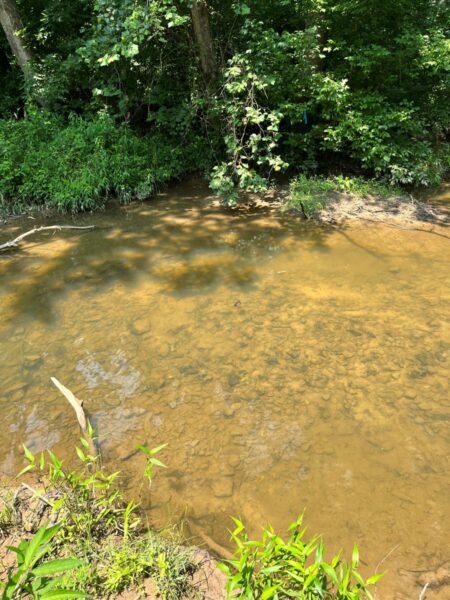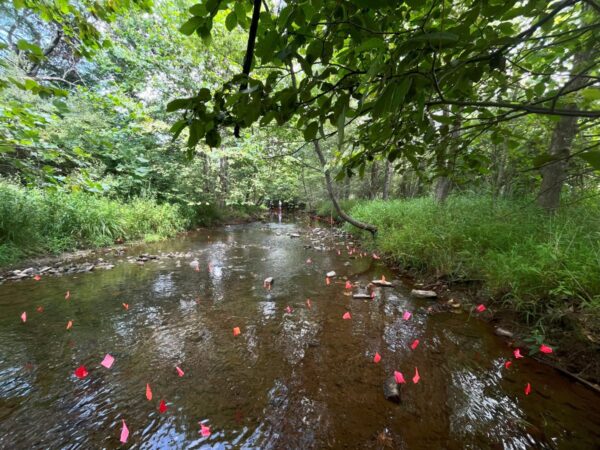Adult James Spinymussel with a 3 mm spine. Photo by ©Kayla Howard - DWR
James Spinymussel (left) and the co-occurring Notched Rainbow (right). Photo by ©Kayla Howard - DWR
Young James Spinymussel tagged during a capture-mark-recapture survey. Photo by ©Kayla Howard - DWR
Fact File
Scientific Name: Parvaspina collina
Classification: Freshwater Mussel, Family Unionidae
Conservation Status:
- Federally Endangered in the U.S.
- State Endangered in Virginia
- Species of Greatest Conservation Need-Tier 1a on the Virginia Wildlife Action Plan
Size: James Spinymussel averages 75 mm in length but larger individuals up to 92 mm have been observed
Life Span: James Spinymussel lives for about 30 years
Distribution
The James Spinymussel primarily occurs in the tributaries of the upper James River basin and the Dan and Mayo watersheds in the Roanoke River basin. It has experienced a significant reduction in its range however, introduction efforts of propagated individuals throughout its historic range are currently ongoing.

Identifying Characteristics
- Shell is oval to oblong in shape and somewhat compressed
- The anterior end is round, and the posterior end is bluntly pointed
- The ventral margin can be straight or slightly curved
- The outer covering of the shell (periostracum) is shiny and yellowish-brown in younger individuals, but darkens to brownish-black in color with age
- The shell of younger individuals may have between one and three short spines on each valve, not typically retained with age
- The inner portion of the shell (nacre) is bluish-white
Habitat
The James Spinymussel inhabits small streams to large rivers in mixed sand, gravel, and cobble substrates. It reaches greater abundance in second and third order streams in depths between 0.5 and 3 feet, with a slow to moderate current.

Typical habitat where James Spinymussel may be encountered. Photo by ©Kayla Howard – DWR
Life History
Freshwater mussels have a very unique life cycle. Parasitic larvae, called glochidia, develop in the gills of the female mussel. Once mature, the glochidia are expelled from the gills of the mussel and must attach to the gills of a suitable host fish, where they complete their transformation into a juvenile mussel. They then detach from the fish and begin their free-living existence on the river bottom.
Some freshwater mussels are host-specialists, meaning that metamorphosis can only occur on a limited number of closely related fish species, while others are host-generalists, with the ability to complete their life cycle using many different species. The James Spinymussel relies on minnows from the family Leucisidae, primarily Bluehead Chub (Nocomis leptocephalus). Additional hosts include Rosyside Dace (Clinostomus funduloides), Satinfin Shiner (Cyprinella analostana), Rosefin Shiner (Lythrurus ardens), Central Stoneroller (Campostoma anomalum), Eastern Blacknose Dace (Rhinichthys atratulus), Mountain Redbelly Dace (Chrosomus oreas), White Shiner (Luxilus albeolus), and Crescent Shiner (Luxilus cerasinus).
Conservation
The James Spinymussel was listed as a federally endangered species in 1988. Since that time, many efforts have been made to restore this species in Virginia. A capture-mark-recapture study of several populations in the upper James River basin has been ongoing since 2010, providing DWR valuable information regarding the species’ population dynamics.

A capture-mark-recapture study for James Spinymussel. Flags are placed at each mussel observed in the stream. Photo by ©Kayla Howard – DWR
The Virginia Fisheries and Aquatic Wildlife Center (VFAWC) located at Harrison Lake National Fish Hatchery has been propagating this species since 2015, and as of 2024, over 4,300 James Spinymussel have been released throughout the James and Roanoke River basins.
First Release in the James River Mainstem
In 2022, DWR and VFAWC released approximately 2,000 James Spinymussel back into the mainstem of the James River. Prior to this release, the James Spinymussel had not been observed in the James River for over 50 years!

Propagated James Spinymussel being planted at a reintroduction site. Photo by ©Meghan Marchetti – DWR
Special Considerations
Freshwater mussels are extremely imperiled organisms. DWR regulates the take and possession of freshwater mussels occurring within the state. It is unlawful to take mussels from any inland waters in the Commonwealth except as provided for in §§ 29.1-418 and 29.1-568 of the Code of Virginia. Additionally, the James Spinymussel is listed as an endangered species under federal and Virginia law. It is a violation of both federal and state law to harass, harm, or take the James Spinymussel in Virginia.
For more information, see Virginia’s Endangered Species Act.
Last updated: July 31, 2025
The Virginia Department of Wildlife Resources Species Profile Database serves as a repository of information for Virginia’s fish and wildlife species. The database is managed and curated by the Wildlife Information and Environmental Services (WIES) program. Species profile data, distribution information, and photography is generated by the Virginia Department of Wildlife Resources, State and Federal agencies, Collection Permittees, and other trusted partners. This product is not suitable for legal, engineering, or surveying use. The Virginia Department of Wildlife Resources does not accept responsibility for any missing data, inaccuracies, or other errors which may exist. In accordance with the terms of service for this product, you agree to this disclaimer.

